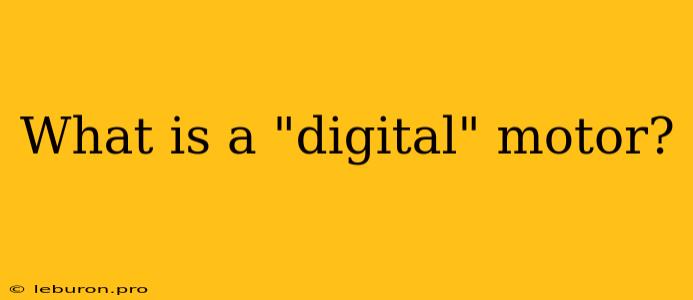What is a "Digital" Motor?
The term "digital motor" might sound like a futuristic concept, conjuring images of high-tech robots and advanced automation. While the term itself isn't officially standardized, it's often used to describe a particular type of electric motor that utilizes digital control techniques to achieve precise and efficient performance. These motors aren't fundamentally different from traditional electric motors, but the way they are controlled sets them apart. This article will delve deeper into the world of digital motors, exploring their characteristics, advantages, and applications.
Understanding the Basics: How Digital Motors Work
Before diving into the digital aspect, it's essential to understand the basic principles of electric motors. Electric motors convert electrical energy into mechanical energy, using the interaction between magnetic fields and electrical currents. A typical electric motor comprises a stator (stationary part) and a rotor (rotating part). When electrical current flows through the stator windings, it generates a magnetic field that interacts with the magnetic field of the rotor, causing it to rotate.
The Role of Digital Control
Digital control is where the "digital" motor earns its name. Instead of relying on analog control methods, digital motors use digital signals to control their operation. This involves using microcontrollers or dedicated digital control systems to precisely manage the current flowing through the motor windings. Here's how it works:
- Signal Processing: The control system receives real-time feedback from sensors about the motor's speed, position, and other parameters.
- Algorithm Execution: This information is fed into a digital control algorithm that determines the optimal current waveform and timing to achieve the desired motor performance.
- PWM Generation: The control system generates a Pulse Width Modulation (PWM) signal. This signal is a series of pulses with varying widths, which effectively control the average current flow through the motor windings.
- Motor Control: The PWM signal drives power electronics that convert the DC power supply into the required AC current to power the motor.
Advantages of Digital Motors
The integration of digital control brings several benefits to electric motors:
- Precise Control: Digital control allows for highly accurate control over motor speed, torque, and position. This is crucial in applications requiring precise movement, like robotics and automation.
- Increased Efficiency: Digital control optimizes the motor's operation by minimizing losses and maximizing energy utilization.
- Improved Reliability: Digital control can detect and compensate for various faults and anomalies, improving the overall reliability of the motor.
- Enhanced Flexibility: Digital control enables the implementation of advanced features like multi-motor coordination and complex motion profiles.
Different Types of Digital Motors
While the term "digital motor" is not universally standardized, some common types of motors are commonly associated with digital control:
- Brushless DC (BLDC) Motors: BLDC motors are popular for their high efficiency and precise control. They use digital control to manage the commutation process (switching the current flow through the windings) for smooth and controlled rotation.
- Stepper Motors: Stepper motors move in discrete steps, making them ideal for precise positioning applications. Digital control is used to precisely control the steps and direction of rotation.
- Servo Motors: Servo motors are used in applications requiring high precision and feedback. They use digital control for accurate positioning and speed regulation.
Applications of Digital Motors
The advantages of digital motors have led to their widespread adoption in various industries:
- Robotics: Digital motors are essential for robotic systems, powering actuators and enabling precise movement for tasks like assembly, manipulation, and locomotion.
- Automation: In industrial automation, digital motors drive machines and systems for tasks like packaging, material handling, and production line control.
- Automotive: Digital motors are used in electric vehicles (EVs) for propulsion, power steering, and other functions.
- Aerospace: Digital motors are employed in aircraft and spacecraft for actuation systems, flight control, and propulsion.
- Consumer Electronics: Digital motors power devices like smartphones, drones, and home appliances.
Conclusion
"Digital" motors are not a separate type of motor but rather a specific way of controlling electric motors. By employing digital control techniques, they achieve greater precision, efficiency, and reliability. Their versatility and advanced capabilities make them ideal for a wide range of applications, driving advancements in various industries and shaping the future of automation and technology.
